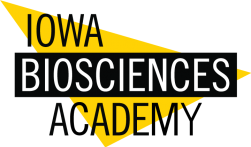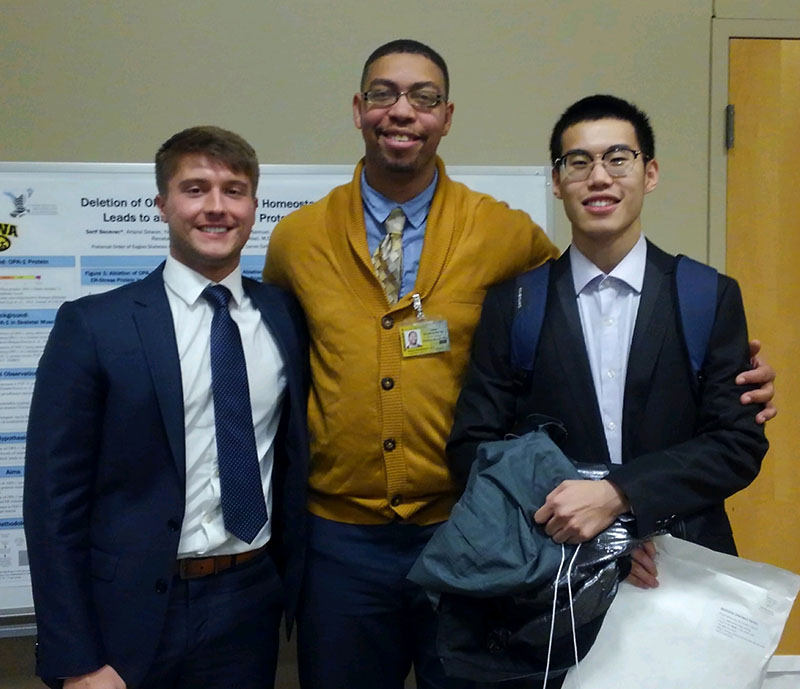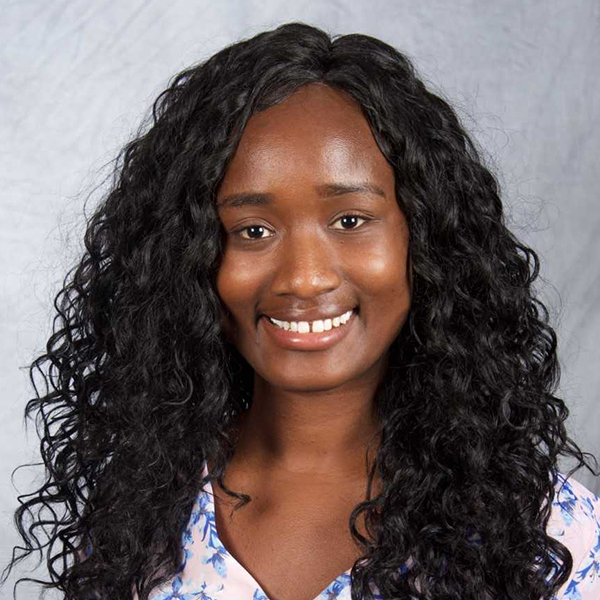The University of Iowa has several resources that connect undergraduate students to unique experiences, including participation in the groundbreaking, influential research conducted in the Internal Medicine labs. The Iowa Center for Research by Undergraduates (ICRU), a unit of the Office for the Vice President of Research (OVPR), reports that 30% of senior undergraduates are involved in some kind of research at the University of Iowa. Thanks to these programs that allow our department to connect with aspiring researchers, Internal Medicine currently employs more than a hundred undergraduates to assist in our labs.
ICRU is one of the many organizations that encourage undergraduates to begin their research careers early by connecting students with new opportunities and recruiting undergraduate ambassadors who organize and support these connections. Ambassadors meet with prospective students during campus visits, current students in classes, and during the office’s walk-in hours.
 Besides ICRU, there are several different programs at Iowa promoting undergraduate participation in research, particularly those that work with populations traditionally underrepresented in STEM majors and careers. Lori Adams, PhD, associate professor of Instruction in the Biology Department, directs the Iowa Biosciences Academy (IBA), which connects undergraduates interested in biosciences to many career development resources. The IBA is funded in part by the National Institutes of Health and the OVPR in order to help identify promising undergraduates and provide them guidance and mentorship.
Besides ICRU, there are several different programs at Iowa promoting undergraduate participation in research, particularly those that work with populations traditionally underrepresented in STEM majors and careers. Lori Adams, PhD, associate professor of Instruction in the Biology Department, directs the Iowa Biosciences Academy (IBA), which connects undergraduates interested in biosciences to many career development resources. The IBA is funded in part by the National Institutes of Health and the OVPR in order to help identify promising undergraduates and provide them guidance and mentorship.
In just one component of the IBA’s broad curriculum, ranging from paid, hands-on lab work to critical analysis of findings, Adams teaches a scientific career development class, in which students learn to write research statements, CVs, resumes, and applications for a wide variety of opportunities. Additionally, Adams runs an IBA seminar where students learn how to deliver presentations and what kinds of questions to ask during and following a presentation in a journal club.
Adams and Vincent G. J. Rodgers, PhD, professor in the Department of Physics and Astronomy, also direct the University of Iowa Chapter of the Iowa, Illinois, Nebraska STEM Partnership for Innovation in Research and Education, a National Science Foundation-funded Louis Stokes Alliance for Minority Participation (IINSPIRE LSAMP), which works with institutions to increase minority participation in STEM majors. LSAMP provides minority students an alliance to build a foundation for greater success in future years with a mix of rigorous instruction, social support, and a variety of targeted scholarships.

Similarly, Denise Martinez, MD, associate professor in the Department of Family Medicine, advises the Minority Association of Pre-Health Students (MAPS), an organization that provides minority undergraduate students with more inclusive research opportunities. Although MAPS mainly provide services to minority students, the University of Iowa’s chapter website encourages any pre-medical or pre-health student to join. Because the MAPS weekly meeting provides students an arena to bond and network, MAPS also serves as a moral support system for students tackling the challenge of juggling school, extracurricular activities, and research.
 Another organization that inspires research and builds a community is University of Iowa’s Women in Science and Engineering (WiSE), headed by Linda Varvel. WiSE provides academic, social, professional, and research support to undergraduate women in engineering majors, including Biomedical and Chemical Engineering. WiSE not only shares and promotes the research opportunities around campus but also provides first-year WiSE members the opportunity to receive one-on-one peer mentoring from more senior members.
Another organization that inspires research and builds a community is University of Iowa’s Women in Science and Engineering (WiSE), headed by Linda Varvel. WiSE provides academic, social, professional, and research support to undergraduate women in engineering majors, including Biomedical and Chemical Engineering. WiSE not only shares and promotes the research opportunities around campus but also provides first-year WiSE members the opportunity to receive one-on-one peer mentoring from more senior members.
 The Society of Women Engineers (SWE) also encourages the participation of women in STEM fields through professional development services, seminars, and events. SWE strives to create a community and expand the number of women engineers by holding conferences for high school students interested in engineering as well as reaching out to elementary and middle school students.
The Society of Women Engineers (SWE) also encourages the participation of women in STEM fields through professional development services, seminars, and events. SWE strives to create a community and expand the number of women engineers by holding conferences for high school students interested in engineering as well as reaching out to elementary and middle school students.
General qualifications for participating in research at the University of Iowa vary depending on advisors, lab directors, and principal investigator standards. “Many mentors are pleased to bring students in as high school students or college freshman and only care about the level of curiosity and commitment shown, while other mentors look for students who have already had a specific collection of classroom experiences that provide them with a specific base of knowledge to bring to the opportunity,” Robert Kirby, PhD, director of ICRU, said. “What all mentors look for is responsibility and an interest in learning.”
At the same time as these organizations help generate and sustain interest in undergraduate participation in research, Internal Medicine lab members assess whether the student would be the best fit for their lab. Here are some examples of what the Internal Medicine labs look for.
The London Lab
 Investigating molecular and genetic causes of cardiac death, Barry London, MD, PhD, professor and division director of Cardiovascular Medicine, looks for intellectual curiosity, enthusiasm, a positive attitude, and strong organizational skills.
Investigating molecular and genetic causes of cardiac death, Barry London, MD, PhD, professor and division director of Cardiovascular Medicine, looks for intellectual curiosity, enthusiasm, a positive attitude, and strong organizational skills.
To provide more personalized instruction, most Internal Medicine labs assign graduate students or research managers to directly mentor undergraduate hires. Daniel Matasic, a graduate researcher in the London Lab, started his career in research as an undergraduate himself almost ten years ago and now mentors undergraduate researchers along with fellow graduate student Alex Greiner.
“Working in a research lab as a student is invaluable. The experience enhances the undergraduate education by bringing textbook concepts from classes alive by putting them in the context of real-world questions, applications, problems,” Matasic said. He cites his own experience as an undergraduate researcher at Pennsylvania State University for influencing his decision to become a physician-scientist.
Abagail McKernan, an undergraduate student in the London Lab and a Latham Science Engagement fellow, has found great success after applying to be a member of the lab her freshman year. Now, three years later, McKernan assists Greiner and Matasic with identifying genetic variants that cause cardiovascular disease. McKernan analyzes the correlation between cardiovascular disease and genes in mice genetically engineered with or without the gene believed to be causing cardiovascular disease.
 “So many opportunities have come of my research with Dr. London,” McKernan said. “I have had opportunities to present current research at poster presentations and I have formed relationships with impactful individuals in the scientific community. Because of my experience in Dr. London’s lab, I am determined to make research a large part of my career. If you would have asked freshman Abagail if she wanted to pursue a PhD, I would have given a resounding ‘no,’ but now I cannot imagine my life without it.”
“So many opportunities have come of my research with Dr. London,” McKernan said. “I have had opportunities to present current research at poster presentations and I have formed relationships with impactful individuals in the scientific community. Because of my experience in Dr. London’s lab, I am determined to make research a large part of my career. If you would have asked freshman Abagail if she wanted to pursue a PhD, I would have given a resounding ‘no,’ but now I cannot imagine my life without it.”
The Abel Lab
Antentor “AJ” Hinton Jr., PhD, Burroughs Wellcome and Ford Foundation Postdoctoral Research Fellow, works in the lab of E. Dale Abel, MD, PhD, director of the Fraternal Order of Eagles Diabetes Research Center. Hinton also had the opportunity to participate in research as an undergraduate student at Winston-Salem State University through the Maximizing Access to Research Careers Undergraduate Student Training in Research (MARC U-STAR) program, which is similar to many of the programs described above. Hinton’s undergraduate experience fostered his passion for undergraduate education, and now he serves as a secondary-mentor to many of the undergraduate students in the Abel Lab. Since his graduate student days at Baylor College of Medicine, Hinton has taken this work seriously.
“You’re raising the next generation!” Hinton said. “If you train them like an undergrad,  they’re not going to be ready for that next step. However, if you train them like a graduate or a medical student, they will rise to the occasion. Interestingly, if you expect them to do more, they’ll expect themselves to do more, and they’ll find more success.”
they’re not going to be ready for that next step. However, if you train them like a graduate or a medical student, they will rise to the occasion. Interestingly, if you expect them to do more, they’ll expect themselves to do more, and they’ll find more success.”
Hinton credits some of the later success of undergraduate students in the Abel Lab to the real-life, bench-to-bedside experiences provided in their lab. With access to donor heart samples and active human and murine primary cell lines, undergraduate students gain exposure to material identical to what they will see later in their career, long before many students at other institutions.
A primary focus of the Abel Lab is on the effects mitochondrial fusion and fission dysfunction have on diabetes. Smaller research projects that support this bigger question get assigned to graduate and undergraduate students. Margaret Mungai, an undergraduate student in the Abel Lab, has been looking at mitochondria’s response to lack of the protein OPA1 that loss’s effect on mitochondria and endoplasmic reticulum cites (MERC), which has been correlated with Type 2 Diabetes and insulin resistance. So far, she has found that with the loss of OPA1, there is an increase in MERCs in order to relieve mitochondria stress caused by OPA1 deficiency. Earlier this year, Mungai received special recognition for this project work with an Excellence in Undergraduate Research award from ICRU.
 Mungai says that a lot of what she does in the lab comes in handy in her coursework. “In Cell Biology when we covered the mitochondria unit, mitochondrial metabolism, endoplasmic reticulum and sarcoplasmic reticulum, and laboratory techniques, I was familiar with it and I could ask higher-level questions. Furthermore, I have been able to communicate with other professionals in conferences about my research and conversely about theirs,” Mungai said.
Mungai says that a lot of what she does in the lab comes in handy in her coursework. “In Cell Biology when we covered the mitochondria unit, mitochondrial metabolism, endoplasmic reticulum and sarcoplasmic reticulum, and laboratory techniques, I was familiar with it and I could ask higher-level questions. Furthermore, I have been able to communicate with other professionals in conferences about my research and conversely about theirs,” Mungai said.
Mungai aids the growth of undergraduate research at Iowa in her positions as an LSAMP fellow, on the board of the Iowa chapter of WiSE, and as the incoming president of Medicus Premedical Society. In addition to her ICRU award, she also received a travel award to the Annual Biomedical Research Conference for Minority Students.
In the Abel Lab, undergraduate students not only have lab responsibilities, but career development tasks as well. “Instead of washing dishes or other mundane tasks, we actually give them access to a science project, career development training, and resources to communicate their research findings at conferences,” Hinton said.
Aside from CV building, preparing research and personal statements, giving training on how to be cultural competent, teaching students how to network, assisting in studying for the MCAT and GRE, and personalizing individual development plans, the culture of the Abel Lab also emphasizes the importance of using social media to connect with other researchers. All members are encouraged to use GroupMe, ResearchGate, LinkedIn, and Twitter and get instruction in how to construct their scientific posts.
“If students are not having fun, it’s not going to be relevant to them,” Hinton said. “That is why we bring social media into the laboratory. The ‘fun’ aspect needs to happen and if you’re not reaching a student on what they like, then they are not going to blossom.” Hinton identifies four requirements for Abel Lab members: “Have a willingness to learn, be willing to adapt and grow, be humble, and take risks.”
The Zabner Lab
Peter Taft is research manager in the lab of Joseph Zabner, MD, professor and division director of Pulmonary, Critical Care and Occupational Medicine. In the Zabner Lab, undergraduates learn that teamwork is essential to success.
While the undergraduates handle many of the day-to-day lab tasks, the graduate and professional lab members can concentrate on larger research questions. And by looking over the shoulders of the more senior members, undergraduate students in the Zabner Lab also learn about cell culture, molecular biology, and physiology. Those more senior members also provide direct and indirect instruction in maintaining curiosity.
“[Undergraduate students] often have fresh ideas that help with research problems and can do important research themselves,” Taft said. Taft sees undergraduate research as a crucial experience for students interested in a scientific or medical career. He says the Zabner Lab looks for undergraduate members who have the ability to prioritize, learn self-discipline, and ask questions without hesitation.

The Zabner Lab is one of the many Pulmonary research labs that studies cystic fibrosis. These labs have been providing advanced research experiences to undergraduates for several years now. Meghan Hartry spent her first year of college learning and analyzing genetic code and maintaining lab supplies for a number of CF labs. Hartry was also a WiSE and SWE member, eventually becoming the Conference Chair of SWE her senior year. Hartry graduated with a Bachelors in Computer Engineering this past academic year.
At the University of Iowa, our institution strives to impact the future of medicine by encouraging innovative research and discoveries from the very beginning of a student’s education. Throughout the course of their education, we offer career development opportunities to undergraduates when they participate in our research labs. While undergraduate research at Iowa has already received support from organizations like ICRU, IBA and LSAMP, Internal Medicine hopes to continue encouraging more undergraduate research in all our divisions. Over the next couple months, we will highlight more of these Internal Medicine undergraduate researchers who have achieved success and discovered a passion for medicine through their research.
5 comments on “Undergrads gain exposure to Internal Medicine research”